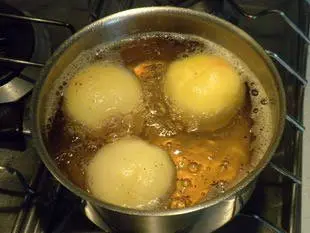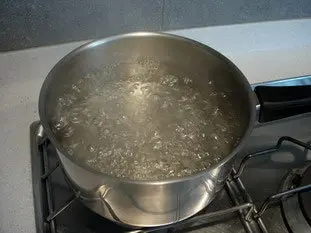This site uses only a few technical cookies necessary for its operation. By continuing to browse, you accept their use.
To find out more...
To find out more...
Sugar syrups
A syrup is simply water and sugar, brought to a boil to mix them well, and then left to cool before use.
The difference is in the ratio of water to sugar, or in other words, how much sugar do you put in how much water?
Of course, starting with 1 liter of water, all weights of sugar are possible, but there are still 2 main proportions very used.
It is used as a base for fruit sorbets, to soak babas or cookies, or to shine the top of a pastry or pastry.
It is used to poach fruits.
Syrups can be kept in a closed container in the fridge, away from the air. They can also be easily frozen.
In summary: A syrup is a mixture of water and sugar in variable proportions, the 2 most used proportions are 1 liter of water for 1 kg of sugar (heavy syrup) or 1 liter of water for 500 gr of sugar (light syrup).
The difference is in the ratio of water to sugar, or in other words, how much sugar do you put in how much water?
Of course, starting with 1 liter of water, all weights of sugar are possible, but there are still 2 main proportions very used.
The heavy syrup
It is a ratio of half and half, 1 liter of water + 1 kilo of sugar. The syrup obtained, quite thick, is called "syrup at 30" by pastry chefs.It is used as a base for fruit sorbets, to soak babas or cookies, or to shine the top of a pastry or pastry.

The light syrup
It is a different ratio, 1 liter of water + 500 gr of sugar. The syrup obtained, quite light, is called "syrup for 60" or "poaching syrup" by pastry chefs.It is used to poach fruits.

How to make it?
It's very simple, you mix sugar and water in the desired proportions in a saucepan, you bring it to boil for 1 minute, you let it cool and it's ready.Syrups can be kept in a closed container in the fridge, away from the air. They can also be easily frozen.
The degree of a syrup
As indicated above, the names sometimes refer to a degree, for example 30° for "syrup at 30", it is not a temperature, but an old measure of concentration, the Baumé degree (of the French chemist Antoine Baumé), which is obsolete but whose use, very approximate, still persists.In summary: A syrup is a mixture of water and sugar in variable proportions, the 2 most used proportions are 1 liter of water for 1 kg of sugar (heavy syrup) or 1 liter of water for 500 gr of sugar (light syrup).
Lasts posts
Getting out of the fridge early
Very often when you're cooking, you need to take food or preparations out of the fridge, to use them in the recipe in progress. There's nothing tricky about this: you just take them out of the fridge and use them, usually immediately, in the recipe. But is this really a good method?November 24th 20258525
Who's making the croissants?
When you look at a bakery from the outside, you naturally think that in the bakery, the bakers make the bread, and in the laboratory, the pastry chefs make the cakes. It's very often like that, with each of these professions having quite different ways of working, but sometimes there's also one...November 23th 2025771
Oven height
When we put a dish or cake in the oven, we naturally tend to put it on the middle shelf, and that's what we usually do. But in some cases, this position and height can be a little tricky, so let's find out why.October 8th 20252,3245
The importance of sieving
In recipes that use a fine powder (flour, powdered sugar, etc.), you'll often see the advice to sift before using it. To sift is to pass the powder in question through a sieve (a very fine strainer) before incorporating it into your recipe. It's often advice, but is it really useful?September 3rd 20257,2823
The grease spray
As soon as you have something in a recipe that sticks to the mold, the question always arises as to how difficult it is to remove from the mold. There's nothing more frustrating than breaking your cake when unmolding it, because part of it has stuck in the mold. The classic way to avoid this is...August 26th 20256,8125
Other pages you may also like
The return of the "Norman hole"
You maybe know the "trou normand", this old gastronomic custom typically French which consists in taking a (small) glass of calvados, generally between the last course and the dessert? It's something that seems a bit anachronistic nowadays, having a glass of an alcohol of more than 60° in the...December 18th 202114 K4.8
What is the difference between bakery and patisserie?
This is a question that you may well have asked yourself and which I will attempt to answer. In France the two trades of "boulangerie" (bakery) and "pâtisserie" (patisserie and confectionery) have always been quite distinct, but where exactly do the boundaries lie? .February 7th 2017134 K 14.1
Candied fruits: don't get ripped off
Do you like candied fruit? You might like to nibble a handful or add it to a recipe, like a classic fruit cake or delicious Italian specialities like panettone or sicilian epiphany pie.June 21th 201767 K 24.2
Is it really necessary to cream egg yolks?
Let’s try and answer a question that crops up in cookery and patisserie, even if it verges on the existential: do the egg yolks in a custard recipe really need to be beaten until pale, or not?February 28th 201844 K4.3
The bitterness of endives
As I write these lines, we are entering the endive season, and if you like it, it's time to enjoy it, if possible with your local producers. Endive is good, but the reproach that is often made of it, and children in particular, is: "It's bitter! And it is (somewhat) true of course, endives...February 9th 201914 K4.9
Post a comment or question
Follow this page
If you are interested in this page, you can "follow" it, by entering your email address here. You will then receive a notification immediately each time the page is modified or a new comment is added. Please note that you will need to confirm this following.
Note: We'll never share your e-mail address with anyone else.
Alternatively: you can subscribe to the mailing list of cooling-ez.com , you will receive a e-mail for each new recipe published on the site.










